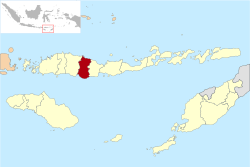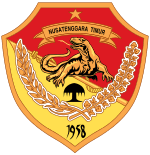Ngada Regency
| Ngada Regency | ||
|---|---|---|
| Regency | ||
| ||
 Location of Ngada Regency in East Nusa Tenggara | ||
| Country | Indonesia | |
| Region | Lesser Sunda Islands | |
| Province | East Nusa Tenggara | |
| Capital | Bajawa | |
| Area | ||
| • Total | 626 sq mi (1,621 km2) | |
| Population (2010 Census) | ||
| • Total | 142,254 | |
| • Density | 230/sq mi (88/km2) | |
Ngada Regency is one of the regencies which divide the island of Flores, East Nusa Tenggara Province, Indonesia. Bajawa is the capital of Ngada Regency. The population of Ngada Regency was 142,254 at the 2010 Census.
History
The Ngada Regency is one of the older regencies (kabupaten) in East Nusa Tenggara, having been formed in 1958. The regency was split into two in 2007, with part being formed into a new Nagekeo Regency.
As is the case with other regencies across Indonesia, local events sometimes seize the headlines. For example, in December 2013 a row broke out when the Ngada regent head (bupati), Marianus Sae, apparently became angered following an altercation over local travel arrangements. On Saturday 21 December 2013 Marianus Sae was apparently unable to obtain a seat on a local flight in East Nusa Tenggara. Angered by the situation, Sae is reported to have ordered his subordinates to blockade the runway of the Turelelo airport in Soa district (kecamatan). The incident attracted national attention leading to a formal investigation of Sae's actions.[1]
Administration
Under current arrangements the Ngada Regency is divided into nine districts (kecamatan), shown below with their 2010 Census population.
| Name | Population Census 2010 |
|---|---|
| Aimere | 14,842 |
| Kerebuu | 7,252 |
| Bajawa | 36,082 |
| Golewa | 36,011 |
| Bajawa Utara (North Bajawa) | 8,489 |
| Soa | 12,745 |
| Riung | 13,875 |
| Riung Barat (West Riung) | 7,759 |
| Wolomeze | 5,338 |
| Total | 142,254 |
Language
The language in Ngada is Ngadha.
Tourism

Ngada regency is one of the poorest regions in Indonesia but there is increasing in popularity among international tourists which is providing some help to the local economy.[2]
The two most visited areas in the Ngada region are Bena[3] and Wogo, both unique megalithic complexes with traditional housing.[4] To Ngadha society, the traditional houses occupy an important role as organizational units, as villagers must each belong to a house, thereby a clan.[5] Clan totems can be ornately crafted symbols of this social organization.[6]
Culture
The megalithic sites in Ngada region were added to the UNESCO World Heritage Tentative List on October 19, 1995 in the Cultural category.[7]

Soa Valley
In 1968 stegodon fossil and stone artefacts were found in the Soa Valley north of Bajawa. In 1991 excavations were carried out but no significant discoveries were found. In excavations in 1994 researchers found 12 sites of artefacts and the fossils. The age of the Soa Valley is put at around 650,000 to 1.02 million years during which time there were at least two devastating volcanic events. So far, researchers have not found human fossils but it is believed that human fossils may yet be found. Stone artefacts suggesting hominin activity have been found in caves such as Mata Menge in the area.[8] If human fossils are indeed found, this may contribute to knowledge about migration into eastern Indonesia.[9] Research at nearby Liang Bua cave to the west near Ruteng has also contributed to expanding knowledge about early human activity in the area.
References
- ↑ Yuliasri Perdani and Markus Makur, 'Gov gives green light to question Ngada regent', The Jakarta Post, 27 December 2013.
- ↑ Phillimore, J. & Lisa Goodson (2004) p 293.
- ↑ Picture of Bena.
- ↑ Ngada traditional house and megalithic complex - UNESCO World Heritage Centre
- ↑ Anett Keller, 'Beauty and the East', Jakarta Post Weekender, 30 November 2011
- ↑ Phillimore, J. & Lisa Goodson (2004) p 293.
- ↑ Ngada traditional house and megalithic complex - UNESCO World Heritage Centre
- ↑ Adam Brumm et al (2010). 'Hominins on Flores, Indonesia, by one million years ago', Nature, 464. See also '"Hobbits" may have arrived in Flores much Earlier Than Thought: Scientists', The Jakarta Globe, 19 March 2010.
- ↑ "Bakal Membuka Tabir Baru Migrasi Manusia Purba Lembah Soa". June 23, 2013.
External links
- Ngada traditional house and megalithic complex - UNESCO World Heritage Centre Accessed 2009-02-27.
- Phillimore, J. & Lisa Goodson (2004), Qualitative Research in Tourism: Ontologies, Epistemologies and Methodologies, Routledge, 2004. ISBN 0-415-28087-7

